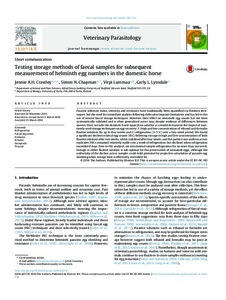Testing storage methods of faecal samples for subsequent measurement of helminth egg numbers in the domestic horse
Chapman Simon; Lumma Virpi; Crawley Jennie; Lynsdale Carly
https://urn.fi/URN:NBN:fi-fe2021042823702
Tiivistelmä
Parasite infection status, intensity and resistance have traditionally been quantified via flotation techniques, but the need for immediate analysis following defecation imposes limitations and has led to the use of several faecal storage techniques. However, their effect on nematode egg counts has not been systematically validated and is often generalised across taxa despite evidence of differences between species. Here, we take the domestic horse Equus ferus caballus as a model to examine the impact of commonly used storage techniques on egg recovery: 1) high and low concentrations of ethanol and formalin fixative solutions for up to four weeks and 2) refrigeration (3–5 °C) over a two-week period. We found a significant decline in faecal egg counts (FEC) following storage in high and low concentrations of both fixative solutions after two weeks, which stabilised after four weeks, and this pattern was uniform across replicates. FECs remained relatively stable over a week of refrigeration, but declined when refrigeration exceeded 8 days. Prior to FEC analysis, we recommend sample refrigeration for no more than one week. Storage in either fixative solution is sub-optimal for the preservation of nematode eggs, although the uniformity of the decline across samples could hold potential for projective calculation of parasite egg shedding when storage time is effectively controlled for.
Kokoelmat
- Rinnakkaistallenteet [19207]
